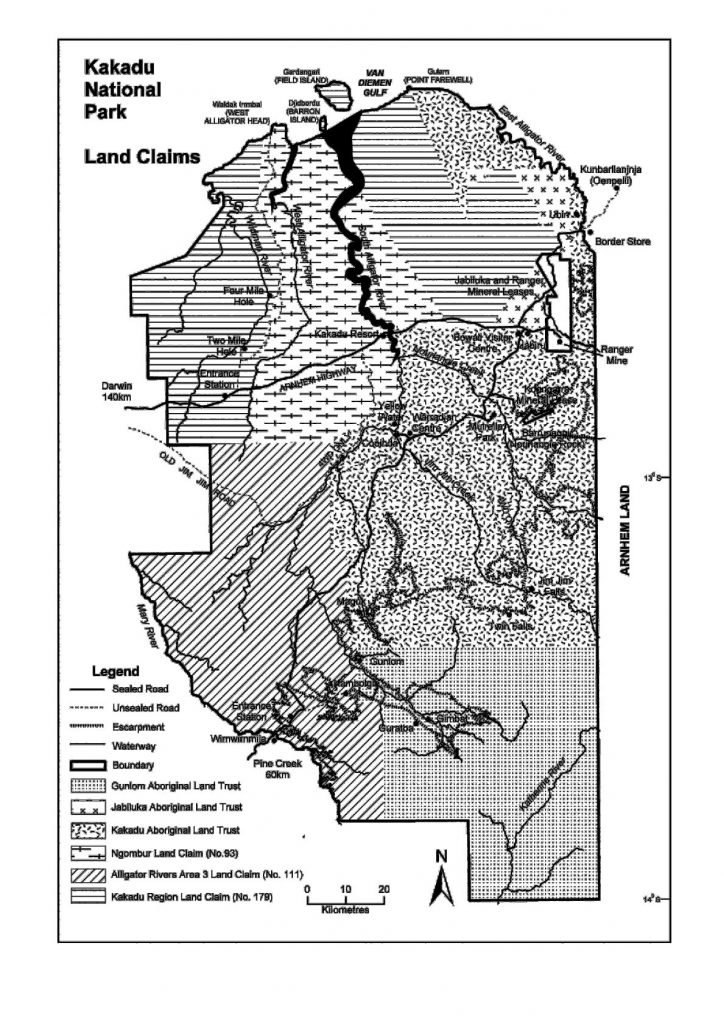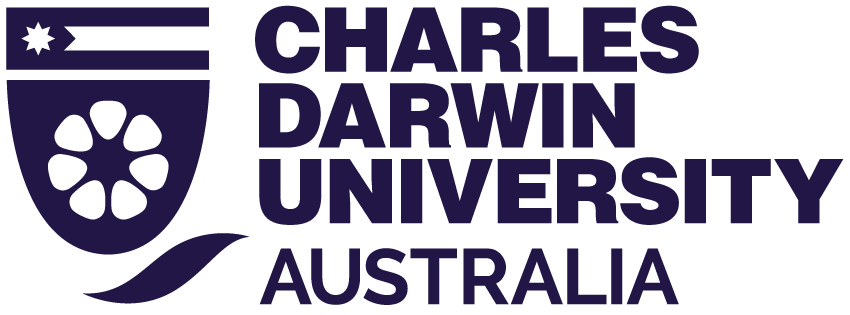SITTGDE013 – Interpret aspects of local Australian Indigenous culture
4 Joint management in Kakadu
Establishment of Kakadu National Park
The earliest proposal for the establishment of a major national park in the Alligator Rivers Region of the Northern Territory was made by the Northern Territory Reserves Board in 1965. Over the next 10 years a succession of modified proposals were put forward by interested persons and agencies. These culminated with a formal proposal by the Commonwealth Government to declare under the National Parks and Wildlife Conservation Acts 1975 (NPWC Act) a major national park in the region. Stage One of Kakadu National Park was declared in 1979, Stage Two was added in 1984, and Stage Three proclaimed in 1987, with supplementary proclamations in 1989 and 1991.
Kakadu National Park was born in controversy and the history of the development of the Park has been one of attempts to reconcile the concurrent and competing interests of conservation, mining and Aboriginal land rights. These issues continue today.
Aboriginal land rights
In the early 1970s Mr Justice Woodward, commissioned to report on appropriate ways and means to establish Aboriginal land rights in the Northern Territory, addressed the issues of Aboriginal land rights and public reserves and crown land. He suggested that a scheme of Aboriginal title, combined with National Park status and joint management, might prove acceptable to all interest. In his second report, Woodward further developed the concept of Aboriginal land, national parks and joint management in the context of reconciling Aboriginal interest with conservation.
In the process he identified a number of principles which needed to be followed if Aboriginal interest were not to be subordinated unreasonably to those of conservation. These principles were: Aboriginal people should be consulted before any schemes for developments or management were adopted; Aboriginal people should be well represented on any board or committee responsible for the area in question; other people appointed to a board or committee should have sympathy with, and an understanding of, the relationship of Aboriginal people to their land; Aboriginal interests should not be overruled without reference to some form of arbitration; and development plans should make allowances for any Aboriginal people who may wish to live in the area, particularly those with traditional claims to the land.
Mining
In the early 1970s significant uranium deposits were discovered in the Alligator Rivers region at Ranger, Jabiluka and Koongarra. In 1975, following receipt of a formal proposal to develop the ranger deposit, the Commonwealth Government directed that an inquiry under the provisions of the Environment Protection (Impact of proposals) Act 1974, the Ranger Uranium Environmental Inquiry (otherwise known as the Fox Inquiry), be conducted. The recommendations of this inquiry had enormous influence on the nature and development of Kakadu National Park.
In 1976, after the Ranger Uranium Environmental Inquiry had commenced its work, the Aboriginal Land Rights (Northern Territory) Act 1976 was passed by Federal Parliament. This act granted title to certain areas in the Northern Territory to the traditional Aboriginal owners and established the processes whereby Aboriginal people could claim title to other areas of unalienated crown land on the basis of traditional ownership of that land, or entitlement by tradition to its use or occupation. The first land claim in the Alligator Rivers region was subsequently dealt with as part of the Ranger Inquiry.
Justice Fox, the Commissioner appointed to head the Inquiry, concluded that the major land use interests in the region should be: the use and occupation of land by Aboriginal people; the establishment of a national park; uranium mining; tourism; and pastoral activities. The Commission’s principal recommendations were: grant of title to the area claimed to the Aboriginals claimants; allowance of uranium mining at Ranger and consideration of future uranium mining at Jabiluka and Koongarra; the establishment of a large regional national park to include the proposed Aboriginal land; the resumption of two pastoral leases to enable Aboriginal land claims to be made over the area and the future incorporation of these additional areas into the national park; inclusion in the park of a regional centre, to be established to service the uranium mining operations; prohibited (initially) of tourist developments in the regional centre ; and preparation of a plan of management for the park, which should ensure that Aboriginal views were strongly represented.
In submitting the land claims to the Commission the traditional Aboriginal owners had instructed the Northern Land Council, which represented them, to propose that if the claim was successful they would lease the land to the Director of National Parks and Wildlife for the purpose of a national park.
The Commonwealth Government response to the recommendations of the Ranger Uranium Environmental Inquiry was announced in August 1977. Virtually all the recommendations were accepted including those relating to the granting of Aboriginal title and the establishment of a major national park. The Government decided to establish the national park in stages with the first stage to coincide generally with the area proposed as Aboriginal land.
Reference: Press, T. & Lawrence, D. 1995 “Reconciling competing interests”, Kakadu—Natural and Cultural Heritage and Management, Australian Nature Conservation Agency, Kakadu National Park, pp. 1–3.
Land ownership
Approximately half of the land in the Park is Aboriginal land under the Aboriginal Land Rights (Northern Territory) Act 1976 and most of the remaining land is currently under claim by Aboriginal people. The areas of the Park that are owned by Aboriginal people are leased by the traditional owners to the Director of Parks Australia to be managed as a national park. The remaining area is Commonwealth land vested in the Director of Parks Australia. All of Kakadu is declared a National Park under the Environment Protection and Biodiversity Conservation Act 1999.
When Kakadu was established, several lease areas are surrounded by the Park but not legally within the Park—the Border Store, Cooinda Lodge, and the Ranger, Jabiluka and past Koongarra mineral leases. The two remaining mineral leases are on Aboriginal land. Energy Resources of Australia holds the Ranger and Jabiluka mineral leases.
There are also several lease areas legally within the Park, including the Kakadu Resort and the Jabiru town area. Jabiru is leased from the Director of Parks Australia to the Jabiru Town Development Authority.
Aboriginal land and land claims in Kakadu National Park
 From the Kakadu National Park Draft Management Plan
From the Kakadu National Park Draft Management Plan
Management structure
All of Kakadu is jointly managed by Aboriginal traditional owners and Parks Australia. Management is directed by the Kakadu Board of Management, which has 15 members:
- Ten (10) Aboriginal representatives of traditional owners;
- Two (2) representatives of Parks Australia (one being the Director of National Parks);
- A person prominent in the field of nature conservation;
- A person employed in the tourism industry in the Northern Territory; and
- A representative from the Northern Territory government.
The Board of Management and the Director of National Parks prepare a Plan of Management for the Park. The Plan of Management describes how the Director and the Board are to manage the Park. Preparing the plans involves detailed consultation with traditional Aboriginal traditional owners, two rounds of public submissions, acceptance by the Minister for the Environment and Energy, and tabling in Federal Parliament. The Board’s other main function is to make decisions about the management of the Park, consistent with the Plan of Management.
Day-to-day management of Kakadu is carried out by people employed by Parks Australia, which is a branch of the Commonwealth environment portfolio, the Department of the Environment and Energy. Approximately one-third of the staff in Kakadu are Aboriginal people.
Vision and Guiding Principles
The vision for Kakadu National Park is that it is a place where the traditional Aboriginal owners and Parks Australia manage the land together to the highest possible standard, to:
- respect the interests of traditional Aboriginal owners;
- conserve the natural and cultural heritage of the park, which is of regional, national and international significance; and
- encourage visitors to appreciate, enjoy and understand the park.
The guiding principles determine how the Park should be managed. They are based on the legal obligations of the Director of National Parks, as set out in the Environmental Protection and Biodiversity Conservation Act 1999 and the lease agreements for Aboriginal land in the Park.
Bininj/Mungguy interests
Over half of Kakadu is owned by Aboriginal people and most of the remaining area is under land claim. Parks Australia consults with Aboriginal people in relation to the management of the entire park area, not just those parts of the Park that are legally Aboriginal land. The Aboriginal people of Kakadu have legal rights, including the right to hunt and forage. They also have economic and community-development aspirations and need to honour obligations imposed on them by Aboriginal tradition. These rights and aspirations will be supported as much as possible.
Caring for country
Conserving the Park’s special natural and cultural heritage is fundamental. Any use of Kakadu’s natural resources should be ecologically sustainable and should not adversely affect biodiversity conservation in the Park.
Kakadu is a cultural landscape as well as a conservation area. It is a place where Aboriginal people have maintained a lifestyle that has been closely linked to the land for many generations—this long, continuing occupation has shaped the landscape as we know it today. Traditional owners maintain a customary responsibility to care for country and to continue their close association with the land.
The Australian Government has joint responsibility with the traditional Aboriginal owners to conserve and monitor the integrity of the Park’s World Heritage attributes and the internationally significant wetlands in the Park.
Research and monitoring play an important role in making sure country is cared for as well as possible.
Tourism
Kakadu is an important place for tourism and recreation. The traditional owners are proud to share parts of their country with visitors, particularly visitors who are interested in learning about their culture and the land. They are keen for visitors to appreciate and enjoy the Park and to develop a special sense of what Kakadu is and means to traditional owners. They are also keen for visitors to take that special understanding home with them. Although people will be encouraged to appreciate and enjoy the Park, tourism will not become a higher management priority than caring for country and supporting Aboriginal rights and aspirations.
Telling people about the Park
It is important that visitors to Kakadu can learn about the Park’s natural and cultural features. Traditional owners want visitors to learn about the Park and Aboriginal culture. Promoting a program to communicate the Park’s heritage and values to visitors and the broader community is integral to management.
Media Attributions
- Land Claims in Kakadu small
